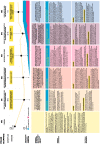Development of a patient journey map for people living with cervical dystonia
- PMID: 35313909
- PMCID: PMC8935780
- DOI: 10.1186/s13023-022-02270-4
Development of a patient journey map for people living with cervical dystonia
Abstract
Background: Patient journey maps are increasingly used as a tool that enables healthcare providers to refine their service provision to best meet patient needs. We developed a cervical dystonia patient journey map (CDPJM) that describes the holistic patient experience from pre-diagnosis through to long-term treatment.
Methods: The CDPJM was developed in 2 stages; a patient survey (open questions and multichoice) of 15 patients with CD was conducted to inform the design of the CDPJM, which was then refined and validated by an expert-patient focus group.
Results: Qualitative analysis of the patient survey supported five key stages of the patient journey: symptom onset, diagnosis and therapeutic relationship with healthcare professionals, initiation of care for CD, start of CD treatment, and living with treated CD. Following symptom onset, survey respondents described having multiple visits to their family doctor who prescribed strong pain killers and muscle relaxants and referred their patient to up to 10 different specialists for diagnosis. Over half (53.3%) of respondents had received ≥ 1 misdiagnosis. Respondents reported relief at having a diagnosis but a lack of understanding of the prognosis and treatment options; 46.7% said their neurologist did not spend enough time addressing their concerns. Survey respondents reported using a variety of alternative sources of information, including the internet (86.7%), self-help groups (66.7%) and information leaflets provided by health care professionals (60.0%). While botulinum toxin (BoNT) was consistently discussed as the main treatment option, some neurologists also mentioned physiotherapy, counselling, and other complementary approaches. However, patients were often left to seek complementary services themselves. Patients reported a 'rollercoaster' of relief with BoNT treatment with symptoms (and subsequent impact on daily life) returning towards the end of an injection cycle. "When BoNT works well I can return to an almost normal life … when the injections stop working so well, I have to rest more and avoid going to work and experience life restrictions."
Conclusions: We present the first patient journey map for CD that can be used to guide local service mapping and to compare current provision with what patients say they want and need.
Keywords: Access to treatment; Cervical dystonia; Patient communication; Patient journey; Patient survey; Rare disease.
© 2022. The Author(s).
Conflict of interest statement
Monika Benson, Carola Reinhard and Holm Graessner are members of the European Reference Network for Rare Neurological Diseases and have no further conflicts to report. Alberto Albanese reports research support from Ipsen, Merz. He is the Specialty Chief Editor Frontiers in Neurology – Movement Disorders Section. Kailash P Bhatia has received grant support from EU Horizon 2020. He receives royalties from publication of the Oxford Specialist Handbook Parkinson’s Disease and Other Movement Disorders (Oxford University Press, 2008), of Marsden’s Book of Movement Disorders (Oxford University Press, 2012), and of Case Studies in Movement Disorders–Common and uncommon presentations (Cambridge University Press, 2017). He has received honoraria/personal compensation for participating as consultant/scientific board member from Ipsen, Allergan, and honoraria for speaking at meetings from Allergan, Ipsen, and the International Parkinson’s Disease and Movement Disorders Society. Pascale Cavillon and Lorraine Cuffe are employed by Ipsen. Kathrin König is employed by PARTNERSEITZ GmbH which was contracted to develop the CDPJM (funded by Ipsen).
Figures
References
Publication types
MeSH terms
LinkOut - more resources
Full Text Sources



